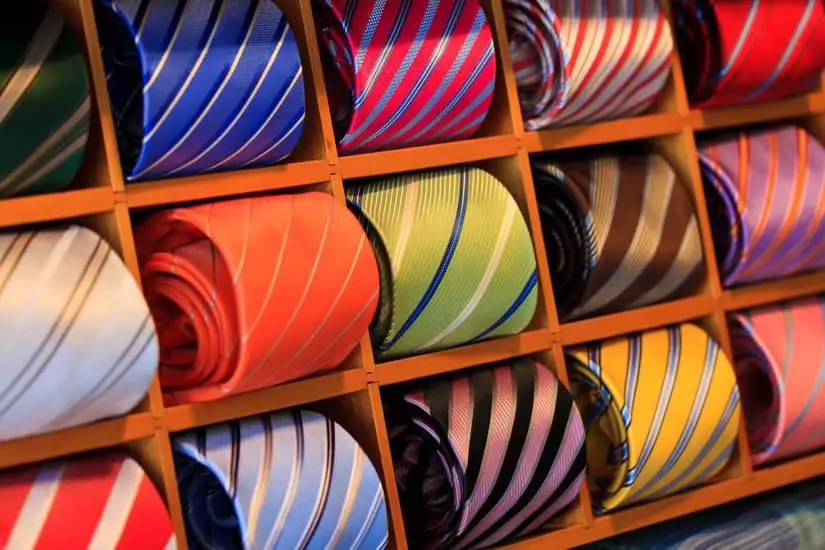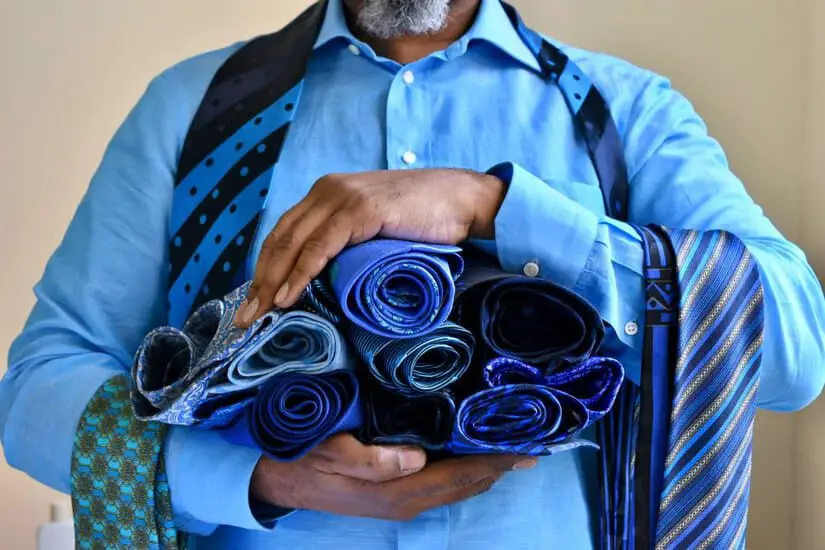Considering the versatility of occasions and the demands of modern professionalism, I’ve come to understand that a man’s wardrobe is simply incomplete without a selection of ties. The question of how many ties you should own, however, isn’t as straightforward as one might think.
It’s a balancing act between variety and necessity, ensuring you have enough for different events without overloading your wardrobe. Owning a well-curated collection is more valuable than having a large number of seldom-worn options.

The ideal number of ties depends on both personal style and lifestyle. For example, if your job requires you to wear a suit daily, you need a broader selection to maintain a fresh look. I suggest starting with at least 10 to 12 ties.
This range allows you to navigate through two weeks of work with unique options, plus a few extra for special occasions or unexpected events. It’s also important to include versatile ties that can work with multiple outfits, such as solid color ties for business settings and a simple black silk tie for formal events.
My philosophy on owning ties also extends to quality over quantity. High-quality ties can elevate an outfit and last longer, giving better investment value. By choosing ties that are both versatile and of good quality, I ensure my collection serves me well across all areas of life, from the boardroom to social engagements.
Understanding the Tie Wardrobe Essentials
In my approach to assembling a well-rounded tie collection, I focus on versatility and personal expression. My wardrobe essentials include ties that serve both professional and social settings.
You will also like:
- What Colors of Ties Are Considered Professional?
- The Ultimate Guide on How To Choose a Tie Pattern
- What Type of Tie Goes with A Striped Shirt?
Defining the Essentials
A man’s tie collection should have a core of essential ties that are timeless and versatile. A solid collection consists of:
- At least one tie for formal occasions: a quality black silk tie that exudes respect and style.
- Striped ties: offering a classic look that pairs well with most suits.
- Textured ties: like a burgundy knit tie, which adds depth to an outfit and works for both casual and formal attire.
These ties form the backbone of a functional wardrobe, ready for a variety of scenes from boardrooms to weddings.
Assessing Personal Style and Lifestyle
Reflect on your daily routine to determine the types of ties that complement your lifestyle. Here’s how I categorize my selections:
- For a daily work environment: a rotation of classic, subtle patterns lets me maintain a professional edge without repetition.
- For social events: I choose ties that show off my personal style, selecting bolder patterns or colors that can be conversational pieces.
- Ties that transition from work to social events: provide efficiency and adaptability in my wardrobe.
I take stock of my existing clothing when deciding on new tie acquisitions, ensuring new pieces work with multiple outfits I already own, to maintain a cohesive and functional wardrobe.
Decoding Tie Colors and Patterns

I’ll guide you through understanding the impact of tie colors and the occasions best suited for various patterns.
The Significance of Color
Navy – Considered a staple, navy ties convey confidence and professionalism. Ideal for business settings, they pair excellently with most suit colors.
Black – The epitome of formality, black ties are essential for events where I recommend dressing your best, such as galas and serious business meetings.
Gray – A versatile option, gray ties work well for those who prefer subtlety while still maintaining a polished look.
Burgundy – This rich, deep color suggests sophistication and is powerful in negotiations and meetings.
Patterns for Every Occasion
Solid Colors – Solid color ties, particularly in navy blue, black, or gray, are foundational for a classic, versatile wardrobe. They’re the easiest to match and a safe bet for virtually any occasion.
Stripes – Striped ties suggest a bold yet professional approach, often aligning with preference for structure and order.
Dots – Consisting of either small or large dots, this pattern adds personality to my attire without overwhelming it, perfect for social events or creative workplaces.
Plaids – Ideal for more casual or festive events, plaids introduce a playful texture to my attire.
Paisley – A paisley tie is a confident choice for when I wish to convey a sense of flair and attention to detail, suitable for both professional and personal settings.
Selecting Ties for Professional and Business Settings
Choosing the right ties for professional and business settings requires attention to detail and an understanding of how they contribute to the desired look. Let’s explore how a tie can serve as a statement in professional settings and how to maintain a business look.
The Tie as a Professional Statement
A tie represents more than an accessory; it’s a statement of style and professionalism. When I curate my tie collection, I ensure that I have at least one solid color tie, which is versatile and offers a dependable business look.
For those key meetings where making an impression is critical, I opt for a restrained polka dot tie, striking the right balance between personality and professionalism. These selections always align with the rest of my professional attire, ensuring a cohesive and tailored appearance.
Maintaining a Business Look
Maintaining a business look for me goes beyond pairing a tie with a suit. I consider the width and length of ties in relation to my suit and body proportion. As recommended, a broad shouldered man like myself should consider a wider tie, while someone with narrower shoulders might opt for a slimmer one.
Maintaining a pristine business look also means caring for my ties properly, ensuring they are undamaged and ready for my next work engagement. To this end, solid colors like burgundy and blue are excellent choices as they convey both professionalism and a sense of style.
Diversity in Your Tie Collection

Having a diverse tie collection is about striking the right balance between versatility and variety. This ensures I have the right tie for any occasion while keeping my wardrobe manageable.
Incorporating Variety and Versatility
When considering the ideal number of ties in your collection, focus on both variety and versatility. A tie isn’t just a means of dressing up; it’s a way to express individuality through different styles and patterns.Your aim is to select ties that can be paired with multiple outfits and suit a wide range of events.
For versatility, include:
- Solid Ties: Essential for both casual and formal events.
- Striped Ties: They offer a professional look perfect for business settings.
- Polka Dot Ties: Adds a fun, yet sophisticated touch to my attire.
When it comes to variety,consider:
- Textures: Options like silk, wool, and knitted ties to suit different seasons and occasions.
- Colors: I ensure I have ties in classic colors such as navy, but also brighter shades for a pop of color.
- Patterns: Beyond stripes and polka dots, options like paisley can add a creative flair to my ensemble.
By having an assortment of ties, I maximize my ability to appear sharp, appropriate, and uniquely dressed for every situation.
The Role of Material and Quality in Ties
When discussing ties, it’s essential to recognize the immense impact that both the material of the tie and the quality of its construction have on its appearance, durability, and comfort.
Different Tie Fabrics
Silk Ties: Silk is traditionally the premier choice for ties due to its natural sheen and smooth texture. It is a delicate fabric but offers a high level of comfort and a pronounced elegance that is suitable for both professional and formal occasions.
- Wool: Wool ties provide a more substantial feel and are perfect for the cooler months of the year. They often feature heavier textures and can lend a more casual or rugged look to your ensemble.
- Cotton Ties: Cotton is a versatile fabric that is easier to maintain than silk or wool. Cotton ties work well for casual and business casual settings.
- Linen: Linen ties are a fantastic option during warmer seasons thanks to their lightweight and breathable nature.
- Cashmere: A cashmere tie offers a unique blend of luxury and warmth, making it a less common but valued addition to a man’s tie collection.
Quality Considerations
In my experience, high-quality ties are characterized by details such as a slip stitch, which allows the tie to return to its original shape after being knotted. Manufacturers who pay attention to such details typically produce a tie with better drape and longevity.
- Comfort and Longevity: Quality ties often use a wool interlining, which serves to provide both structure and comfort.
- Construction: Hand-stitched ties, which might come with a higher price tag, indicate meticulous craftsmanship that machine-sewn ties may not match.
- Attention to Detail: Look for ties with bar tacks and a keeper loop, as these elements suggest a dedication to the tie’s functionality and durability.
When selecting ties, pay close attention to both the fabric and the quality of construction, as these factors greatly influence the tie’s performance and lifespan.
Proper Tie Maintenance and Care

Maintaining my ties in pristine condition involves two critical aspects: understanding when to dry clean or wash them, and implementing proper storage and handling practices to extend their lifespan.
When to Dry Clean or Wash
For most of my ties, dry cleaning is the preferred method of care, especially for silk or wool ties. This gentle process protects the fabric’s integrity and appearance. However, if I encounter a water-soluble stain, I’ll spot clean with seltzer water or club soda. For oil-based stains, applying talcum powder or cornstarch works well to absorb the grease before taking the tie to the dry cleaners.
Storage and Handling Practices
Storage is just as crucial as cleaning. I make it a point never to leave my ties knotted, as this can cause permanent creases. Instead, I carefully unfold and hang them up or roll them to store in a drawer. My closet is arranged so that each tie has its own space, avoiding overcrowding, which can lead to wrinkles and damage. Proper hangers or a tie organizer can prevent my ties from slipping onto the ground and getting crumpled.
Navigating Tie Accessories and Embellishments
When building a tie collection, I find it essential to consider not just neckties but also their accessories and various styles. Each element adds to my personal presentation, allowing me to adapt to any professional or social setting.
Bow Ties and Alternative Options
I’m aware that neckties are the standard, but to vary my look, I often include bow ties and other alternatives like knit ties in my collection. Bow ties are perfect for events where I want to convey a classic or professional appearance, yet they come in various patterns like polka dots and graphic designs, providing an opportunity for personal expression.
Pediatricians or those in creative fields might reach for a novelty tie showcasing stars or playful themes, adding a touch of approachability.
Adding Character with Accessories
To enhance my ensemble, I often turn to men’s accessories that play a complementary role with both neckties and bow ties. For instance, tie bars and clips provide not only function, by keeping my tie in place, but also form, as they can be striking pieces that command attention.
I have also noticed that incorporating a subtle but elegant polka dot tie into the mix can exude confidence. My Accessories: – Tie clip: Silver, sleek, for a sharp look – Pocket square: Adds a pop of color or pattern – Cufflinks: A personalized touch for formal attire}
How Many Ties Is Just Right?

Deciding on the ideal number of ties for you wardrobe is about balancing necessity with personal style.
Finding Your Number
Consider your lifestyle and dress code requirements when determining how many ties to own. If your job or social obligations frequently demand formal attire, a larger selection is crucial. Aim for a diversity of patterns, solids, and textures to handle various occasions and seasons. It’s not just about the number; selecting ties that complement your suits and shirts is equally essential.
The Rule of Thumb for Tie Count
There’s a rule of thumb for tie count that serves as a good starting point. At a bare minimum, I have found that owning about 10 to 12 ties allows for suitable rotation and matching options. This number can serve as a foundation, which I may expand based on my professional and social engagements. An ideal number of ties ensures I’m prepared for any dress code without overstuffing my wardrobe.
Frequently Asked Questions
What is the ideal number of ties for a well-rounded wardrobe?
To ensure readiness for various occasions without cluttering your closet, I suggest a collection of 10 to 12 ties, as this provides ample variety and functionality.
Which types of ties are essential for every man’s collection?
My collection features several must-haves, including solid color ties for versatility, a few patterned ones like stripes and polka dots for added personality, and a classic black silk tie for formal events.
Are there specific tie patterns or colors a man should avoid?
While personal style varies, I avoid overly loud patterns and colors that clash with my usual attire. Aim for ties that complement rather than overpower your outfit.
Can the number of ties a man owns be too few or too many?
Certainly, owning too few ties limits your options, while too many can lead to decision fatigue. Balance is key, so aim to have just enough to match your wardrobe and the occasions you attend.
What guidelines should determine how many ties one should own?
The number of ties to own is dictated by your professional dress code, the frequency of your social events, and my desire to keep my look fresh without being excessive.
How does a man’s lifestyle affect the variety of ties he should have?
Your lifestyle demands a selection of ties ranging from business-appropriate to casual options. Those with a more varied social calendar will benefit from a broader range of styles and colors.

Samoel Ovanessian is the founder and creator of StylishAlpha.com – a website dedicated to men’s fashion. As a proud owner of more than 200 ties, he loves digging through new clothing combinations for everyday use, formal events and even just for fun. You can read more about Samoel here.

